
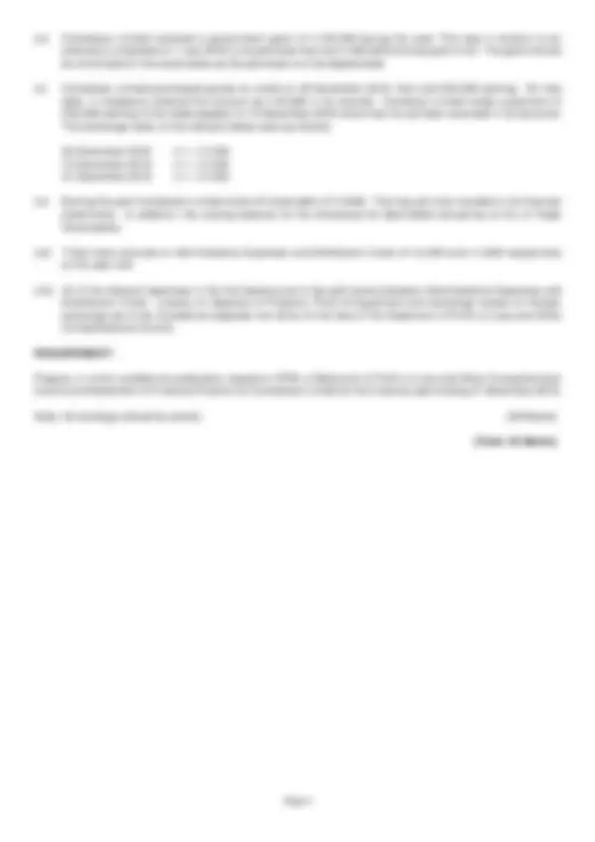
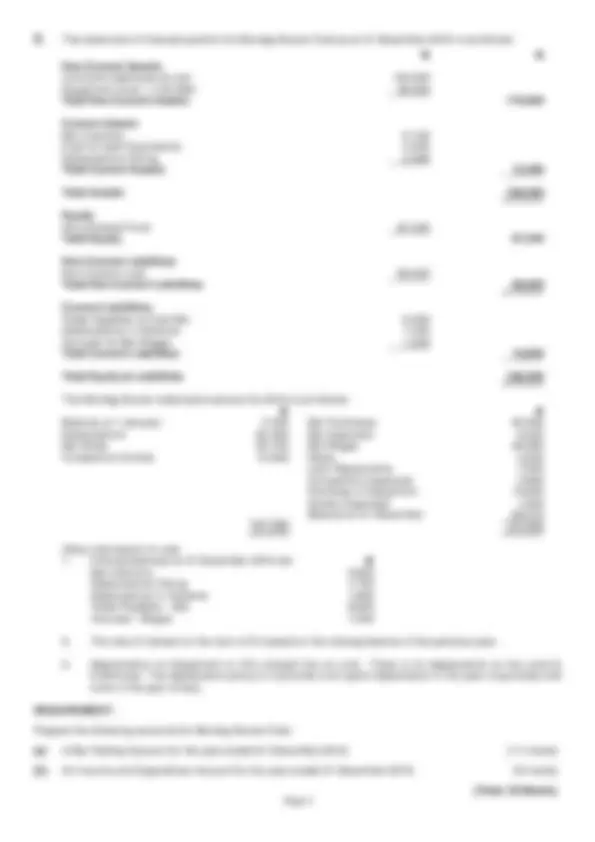
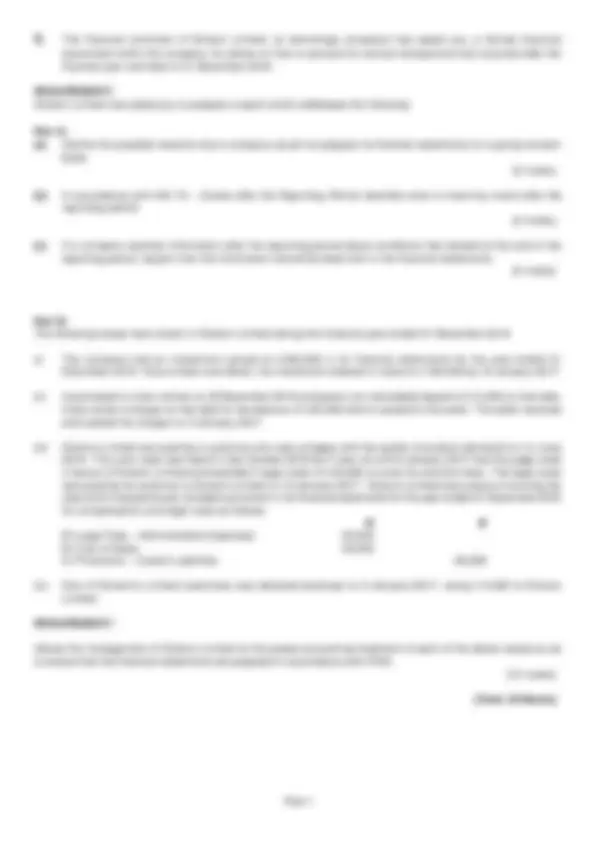
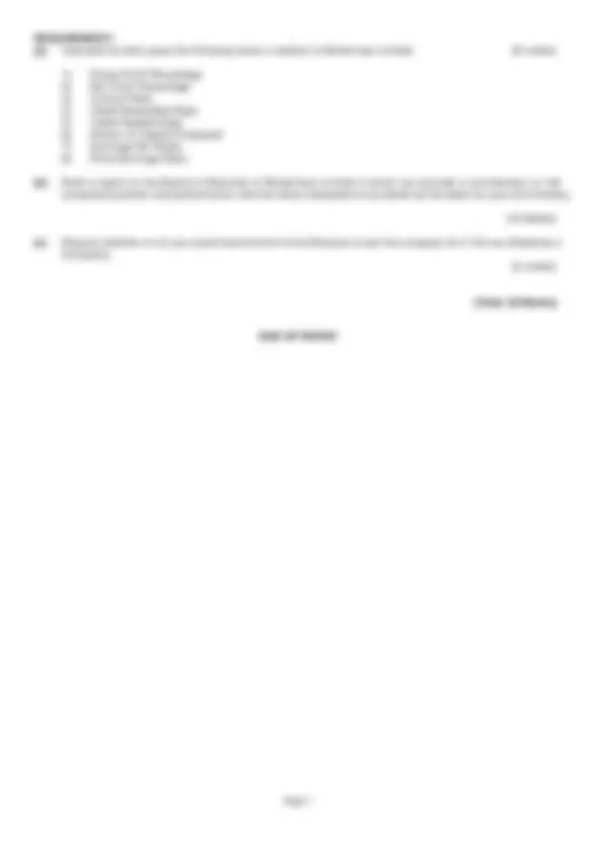
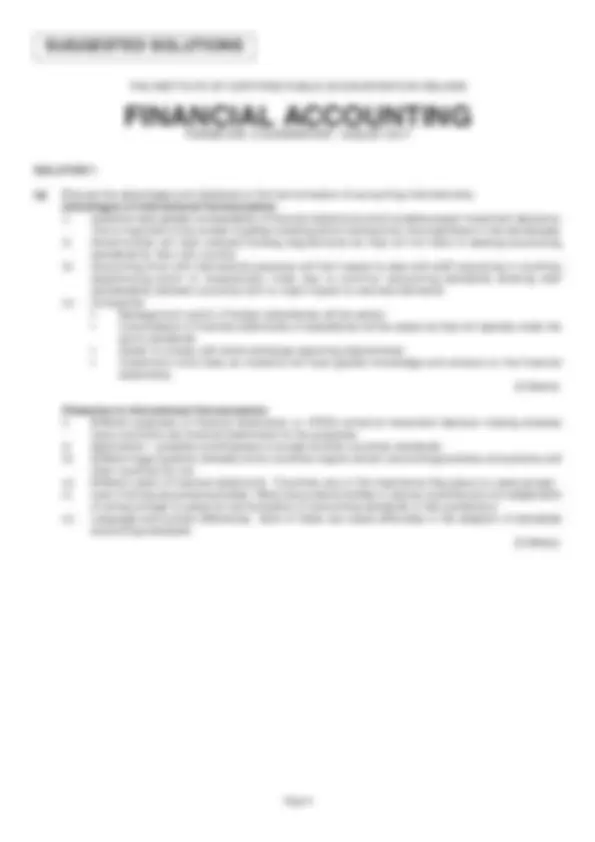
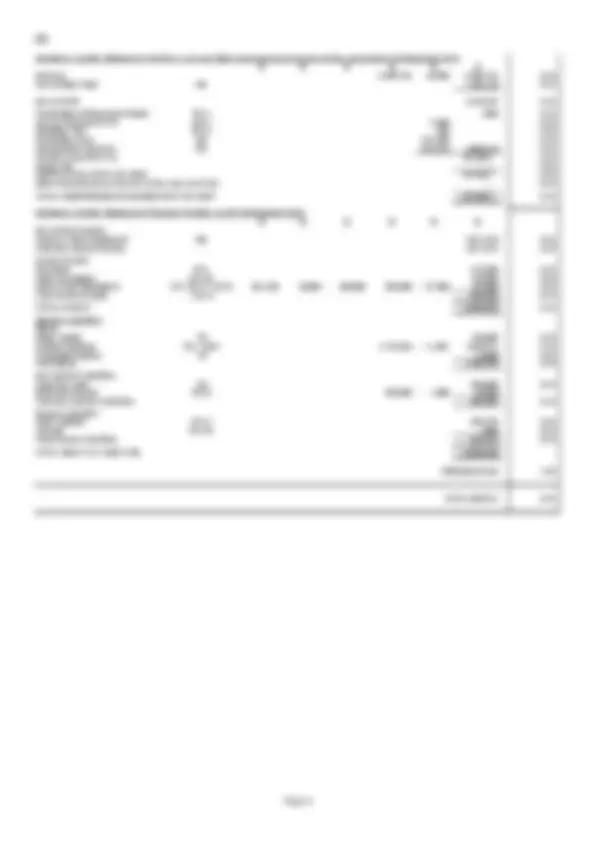
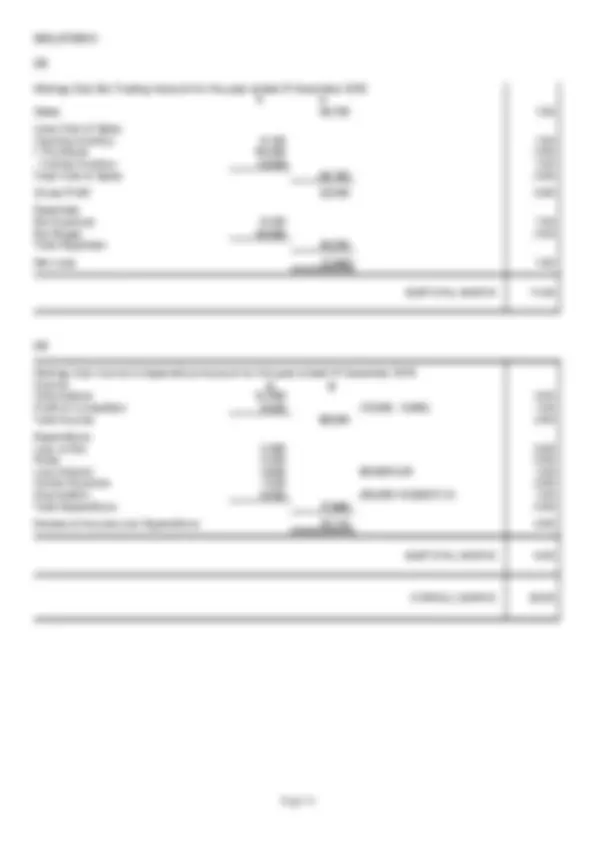
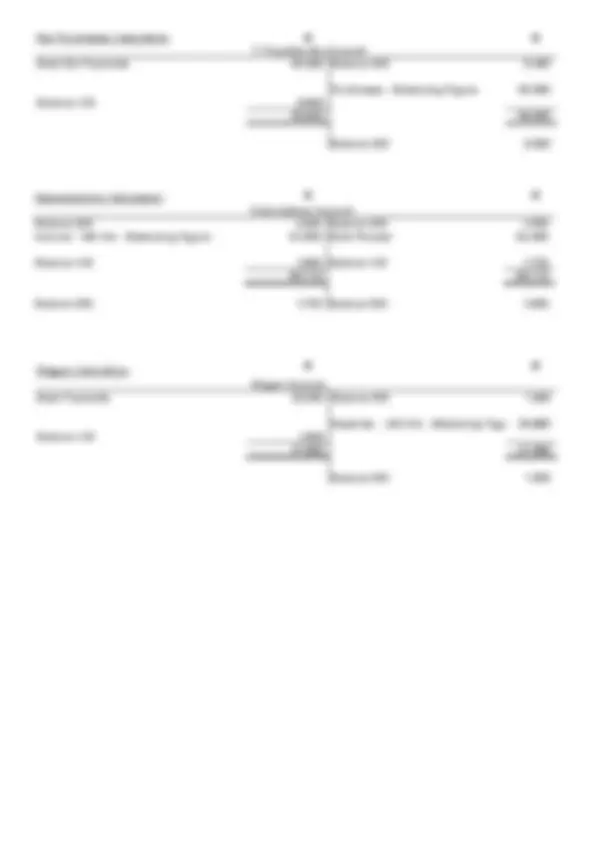
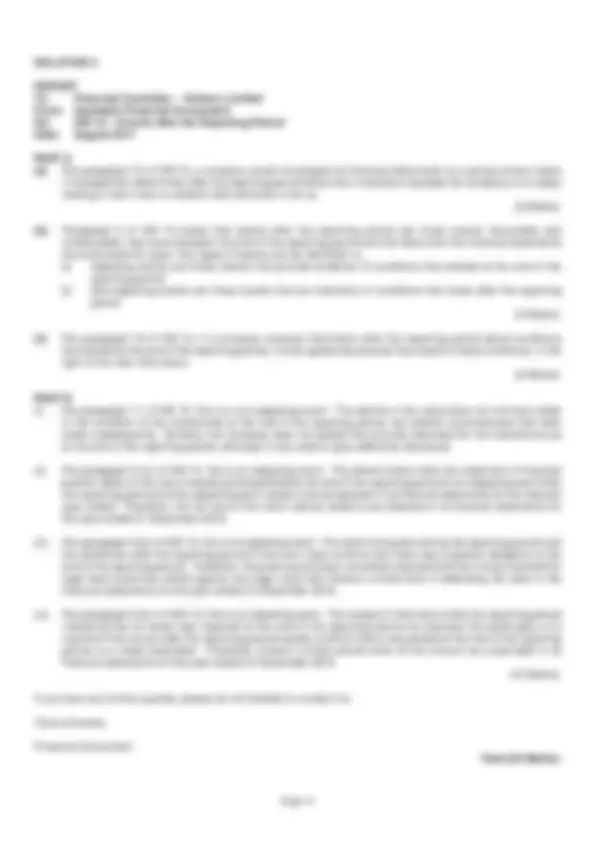
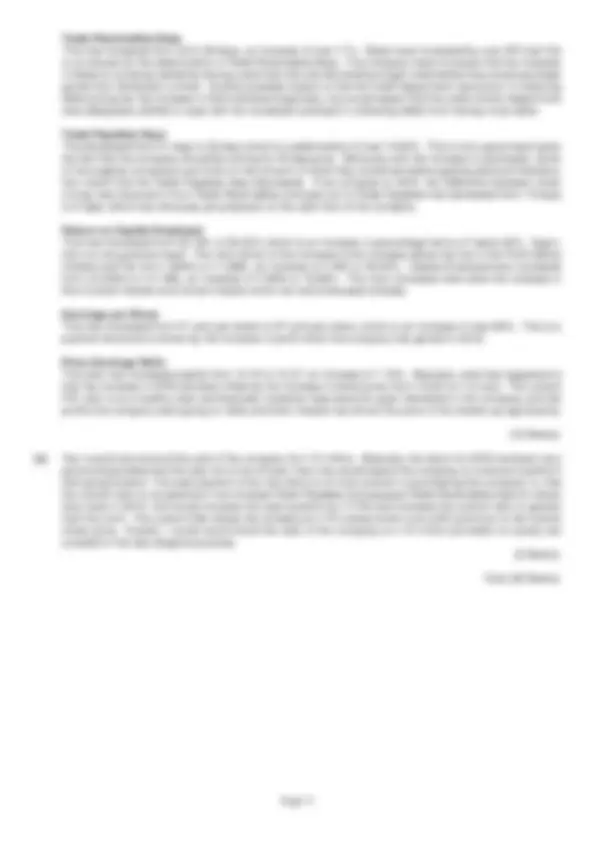
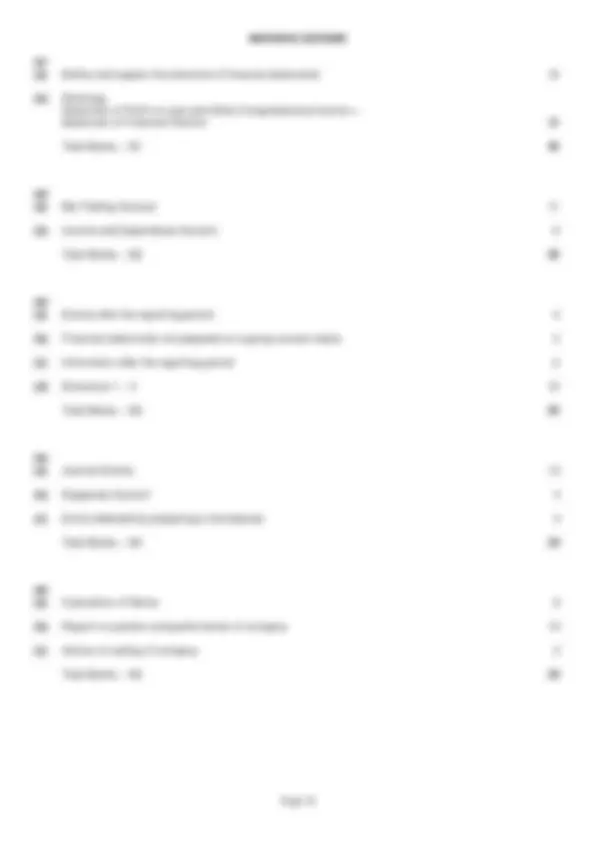


Study with the several resources on Docsity

Earn points by helping other students or get them with a premium plan


Prepare for your exams
Study with the several resources on Docsity

Earn points to download
Earn points by helping other students or get them with a premium plan
Community
Ask the community for help and clear up your study doubts
Discover the best universities in your country according to Docsity users
Free resources
Download our free guides on studying techniques, anxiety management strategies, and thesis advice from Docsity tutors
Financial reporting practice material past year exam paper
Typology: Exams
1 / 19

This page cannot be seen from the preview
Don't miss anything!












You are required to answer Question 1. You are also required to answer any three out of Questions 2 to 5. Should you provide answers to all of Questions 2 to 5, you must draw a clearly distinguishable line through the answer not to be marked. Otherwise, only the first three answers to hand for Questions 2 to 5 will be marked.
Note: Students have optional use of the Extended Trial Balance, which if used, must be included in the answer booklet.
Provided are pro-forma:
Statements of Profit or Loss and Other Comprehensive Income By Expense, Statements of Profit or Loss and Other Comprehensive Income By Function, and Statements of Financial Position.
TIME ALLOWED: 3.5 hours, plus 10 minutes to read the paper.
INSTRUCTIONS: During the reading time you may write notes on the examination paper but you may not commence writing in your answer book.
Marks for each question are shown. The pass mark required is 50% in total over the whole paper.
Start your answer to each question on a new page.
You are reminded to pay particular attention to your communication skills and care must be taken regarding the format and literacy of your solutions. The marking system will take into account the content of your answers and the extent to which answers are supported with relevant legislation, case law or examples where appropriate.
List on the cover of each answer booklet, in the space provided, the number of each question attempted.
FINANCIAL ACCOUNTING
FORMATION 2 EXAMINATION - AUGUST 2017
The Institute of Certified Public Accountants in Ireland, 17 Harcourt Street, Dublin 2.
Time allowed: 3.5 hours plus 10 minutes to read the paper. Answer Question 1 and three of the remaining four questions.
Note: Students have optional use of the Extended Trial Balance, which if used, must be included in the answer booklet.
1.
(a) Discuss the advantages of, and the obstacles to, the harmonisation of accounting standards internationally.
(10 Marks)
(b) The following trial balance was extracted from the books of Cantelaow Limited, a manufacturing company, as at 31 December 2016:
Debit Credit € € Trade Receivables 425, Trade Payables 314, Share Capital - 100,000 at €1.00 each 100, Revenue 2,458, Revaluation Surplus 10, Retained Earnings at 31.12.15 1,716, Purchases 1,457, Premises 1,624, Office Equipment 186, Motor Vehicles 240, Long Term Loan 350, Inventory at 31.12.15 235, Distribution Costs 457, Bank 521, Allowance for Bad Debts 18, Administrative Expenses 489, Accumulated Depreciation - Premises at 31.12.15 458, Accumulated Depreciation - Motor Vehicles at 31.12.15 86, Accumulated Depreciation - Office Equipment at 31.12.15 124, 5,638,103 5,638,
The following information, based on your investigations, has also come to light;
(i) Cantelaow Limited’s inventory was counted on 29 December 2016 and amounted to €246,200 at cost. On 31 December 2016, there were credit sales of €40,000 that still needed to be accounted for in its financial statements. Cantelaow Limited typically makes a profit margin of 25% on its sales.
(ii) Cantelaow Limited sold a motor vehicle on 1 April 2016 for €10,000. It purchased the motor vehicle on 1 January 2014 for €24,000.
(iii) Depreciation is to be charged as follows:
Premises 2% Straight Line on Cost Office Equipment 25% Reducing Balance Motor Vehicles 20% Straight Line on Cost
Depreciation is charged from the date of purchase to the date of sale.
2. The statement of financial position for Montag Soccer Club as at 31 December 2015 is as follows:
€ € Non-Current Assets Land and clubhouse at cost 140, Equipment (Cost = €50,000) 36, Total Non-Current Assets 176,
Current Assets Bar Inventory 6, Cash & Cash Equivalents 4, Subscriptions Owing 2, Total Current Assets 12,
Total Assets 188,
Equity Accumulated Fund 81, Total Equity 81,
Non-Current Liabilities Non-Current Loan 96, Total Non-Current Liabilities 96,
Current Liabilities Trade Payables re Club Bar 8, Subscriptions in Advance 1, Accruals for Bar Wages 1, Total Current Liabilities 10,
Total Equity & Liabilities 188,
The Montag Soccer clubs bank account for 2016 is as follows: € € Balance at 1 January 4,300 Bar Purchases 60, Subscriptions 82,460 Bar Expenses 8, Bar Sales 93,700 Bar Wages 26, Competition Entries 10,830 Rates 3, Loan Repayments 7, Competition Expenses 3, Purchase of Equipment 15, Sundry Expenses 1, Balance at 31 December 65, 191,290 191,
Other information to note:
REQUIREMENT:
Prepare the following accounts for Montag Soccer Club:
(a) A Bar Trading Account for the year ended 31 December 2016; (11 marks)
(b) An Income and Expenditure Account for the year ended 31 December 2016. (9 marks)
[Total: 20 Marks]
3. The financial controller of Octwon Limited, (a technology company) has asked you, a trainee financial
accountant within the company, for advice on how to account for various transactions that occurred after the financial year end date of 31 December 2016.
Octwon Limited has asked you to prepare a report which addresses the following:
Part A: (a) Outline the possible reasons why a company would not prepare its financial statements on a going concern basis. (3 marks)
(b) In accordance with IAS 10 – Events after the Reporting Period , describe what is meant by ‘ event after the reporting period ’. (3 marks)
(c) If a company receives information after the reporting period about conditions that existed at the end of the reporting period, explain how this information should be dealt with in the financial statements. (2 marks)
Part B: The following issues have arisen in Octwon Limited during the financial year ended 31 December 2016
(i) The company had an investment valued at €200,000 in its financial statements for the year ended 31 December 2016. Due to fears over Brexit, the investment reduced in value to €180,000 by 10 January 2017.
(ii) It purchased a motor vehicle on 30 December 2016 and paid a non-refundable deposit of €5,000 on that date. It also wrote a cheque on that date for the balance of €20,000 which it posted to the seller. The seller received and cashed the cheque on 3 January 2017.
(iii) Octwon Limited was sued by a customer who was unhappy with the quality of product delivered to it in June
(iv) One of Octwon’s Limited customers was declared bankrupt on 5 January 2017, owing €4,000 to Octwon Limited.
Advise the management of Octwon Limited on the proper accounting treatment of each of the above issues so as to ensure that the financial statements are prepared in accordance with IFRS. (12 marks)
[Total: 20 Marks]
5. Bohermaw Limited is a company which is involved in the retail trade. The following are their results for the last two years.
Bohermaw Limited Statement of Profit or Loss and Other Comprehensive Income for the year ended 31 December 2016
2016 2015 € ’000 € ’ Sales 5,800 3, Cost of Sales (4,123) (2,863) Gross Profit 1,677 1, Distribution Costs (193) (177) Administration Costs (218) (126) Profit before Interest & Tax 1,266 824 Interest (188) (194) Taxation (108) (120) Profit for the Year 970 510
Bohermaw Limited Statement of Financial Position for the year ended 31 December 2016 2016 2016 2015 2015 € ’000 € ’000 € ’000 € ’ Non-Current Assets 3,610 3,
Current Assets Inventory 580 460 Trade Receivables 460 280 Cash & Cash Equivalents 200 160 Total Current Assets 1,240 900
Total Assets 4,850 4,
Equity & Liabilities
Equity Share Capital 1,000 1, Retained Earnings 1,525 555 Total Equity 2,525 1,
Non-Current Liabilities Long-term Debt 1,700 2, Total Non-Current Liabilities 1,700 2,
Current Liabilities Trade Payables 400 320 Bank Overdraft 147 30 Taxation 108 120 Accruals 47 100 Total Current Liabilities 702 570
Total Equity & Liabilities 4,927 4,
Notes: (i) The Opening Inventory for 2015 was €500,000.
(ii) The number of shares in issue is 1,000,000 for both years. 2016 2015 (iii) Market price per share at year-end €12.00 €6.
(a) Calculate for both years the following ratios in relation to Bohermaw Limited. (8 marks)
(b) Draft a report to the Board of Directors of Bohermaw Limited in which you provide a commentary on the company’s position and performance. Use the ratios calculated at (a) above as the basis for your commentary.
(10 Marks)
(c) Discuss whether or not you would recommend to the Directors to sell the company for €15m as offered by a third party. (2 marks)
[Total: 20 Marks]
!!!!!!
Equity & Liabilities
(a)
Montag Club Bar Trading Account for the year-ended 31 December 2016 !! Sales 93,700 1.
Less Cost of Sales Opening Inventory 6,100 1.
Gross Profit 32,940 0.
Expenses Bar Expenses 8,420 1. Bar Wages 26,880 2. Total Expenses 35,
Net Loss - 2,360 1.
SUBTOTAL MARKS 11.
M
3 P (10,830 - 3,900) 1 T 0.
E 0 R 0 L 96,0000.05 1 S 0 D (50,000+15,000)0.10 1 T 0.
E 0.
S
O
(b)
1.
L 1
G 0.
E 1 B 2 T
N 1.
S
Montag Club Income & Expenditure Account for the year-ended 31 December 2016 Income Subscriptions 81,660 3. Profit on Competition 6,930 (10,830 - 3,900) 1. Total Income 88,590 0.
Expenditure Loss on Bar 2,360 0. Rates 3,200 0. Loan Interest 4,800 96,0000.05 1. Sundry Expenses 1,020 0. Depreciation 6,500 (50,000+15,000)0.10 1. Total Expenditure 17,880 0.
Excess of Income over Expenditure 70,710 0.
SUBTOTAL MARKS 9.
OVERALL MARKS 20.
( )
( )
€ €
Bar Purchases Calculation T. Payables Bar Account Bank Bar Payments 60,360 Balance B/D 8,
Purchases - Balancing Figure 60, Balance C/D 8, 68,960 68,
Balance B/D 8, Subscriptions Calculation Subscriptions Account Balance B/D 2,090 Balance B/D 1, Income - I&E A/c - Balancing Figure 81,660 Bank Receipt 82,
Balance C/D 1,960 Balance C/D 1, 85,710 85,
Balance B/D 1,700 Balance B/D 1,
Wages Calculation Wages Account Bank Payments 26,380 Balance B/D 1,
Expense - I&E A/c - Balancing Figu 26, Balance C/D 1, 27,880 27,
Balance B/D 1,
Balance B/D 8,
P B 6 68,
B S
Balance B/D 1, I Bank Receipt 82,
B Balance C/D 1, 8 85,
B Balance B/D 1,
Wages Calculation Wages Account Bank Payments 26,380 Balance B/D 1,
Expense - I&E A/c - Balancing Figu 26, Balance C/D 1, 27,880 27,
Balance B/D 1,
Balance B/D 8,
P B 6 68,
B Subscriptions Calculation Subscriptions Account Balance B/D 2,090 Balance B/D 1, Income - I&E A/c - Balancing Figure 81,660 Bank Receipt 82,
Balance C/D 1,960 Balance C/D 1, 85,710 85,
Balance B/D 1,700 Balance B/D 1,
W
Balance B/D 1,
B 2 27,
B
€ €
€ €
€ €
a) Issue 1!!!! Should Have Happened Actually Happened Dr. Trade Payables 964 Dr. Trade Payables 964 Cr. Purchase Returns 964 Dr. Purchases 964 Cr. Suspense 1, To Correct Dr. Suspense 1,928 1. Cr. Purchase Returns 964 1. Cr. Purchases 964 1. Issue 2 Should Have Happened Actually Happened Dr. Bank 10,000 Dr. Bank 10, Cr. Bank Loan - Non-Current 10,000 Cr. Equity 10, To Correct Dr. Equity 10,000 1. Cr. Bank Loan - Non-Current 10,000 1. Issue 3 Should Have Happened Actually Happened Dr. Trade Payables 1,000 Dr. Suspense 2, Cr. Bank 1,000 Cr. Trade Receivable 1, Cr. Bank 1, To Correct Dr. Trade Payables 1,000 1. Cr. Trade Receivable 1,000 1. Cr. Suspense 2,000 1. Issue 4 Should Have Happened Actually Happened Dr. Repairs & Maintenance Expense 900 Dr. Insurance Expense 900 Cr. Bank 900 Cr. Bank 900 To Correct Dr. Repairs & Maintenance Expense 900 0. Cr. Insurance Expense 900 0. Issue 5 Should Have Happened Actually Happened Dr. Drawings 1,000 Nothing Cr. Purchases 1, To Correct Dr. Drawings 1,000 1. Cr. Purchases 1,000 1. Issue 6 Should Have Happened Actually Happened Nothing Dr. Bank Interest Expense 400 Cr. Suspense 400 To Correct Dr. Suspense 400 1. Cr. Bank Interest Expense 400 1.
TOTAL MARKS 13. b) Suspense Account 1 Purchase Returns 964 Opening Balance 328 1. 1 Purchases 964 3 Trade Payables 1,000 1. 6 Bank Interest Expense 400 3 Trade Receivable 1,000 1. 2,328 2,328 0.
SUBTOTAL MARKS 4.
c) Errors of Transposition Errors of Omission (if the omission is one-sided) SUBTOTAL MARKS 3. Errors of Commission (if one-sided, or say two debit entries are made for example)
OVERALL MARKS 20.
(a)
(b)
(c)
(a) 2016 2015 Gross Profit Percentage €1,677/ €5,800 = 28.91% €1,127/ €3,990 = 28.25%
Net Profit Percentage €970/ €5,800 = 16.72% €510/ €3,990 = 12.78%
Current Ratio €1,240/ €702 = 1.76:1 €900/ €570 = 1.58:
Trade Receivable Days €460/ €5,800365 = 29 Days €280/ €3,990365 = 26 Days
Trade Payable Days €400/ €4,123365 = 35 Days €320/ €2,863365 = 41 Days
Return on Capital Employed €1,266/ €4,148 = 30.52% €824/ €3,555 = 23.18%
Earnings per Share €970/ €1,000 = €0.97 €510/ €1,000 = €0.
Price Earnings Ratio €12.00/ €0.97 = 12.37 €6.20/ €0.51 = 12. (8 Marks)
(b) To: Board of Directors – Bohermaw Limited From: Assistant Financial Accountant Re: Company’s Position and Performance Date: August 2017
Gross Profit Percentage The Gross Profit percentage has increased from 28.25% to 28.91%, an increase of over 2.33% which is a positive trend for the company. This is also positive for the fact that the company sales increased by over 45%. An increase of this magnitude presented a challenge for a company and the company has in the main responded positively to this challenge. The increase resulted from the fact that sales increased faster than Cost of Sales (44%). However, one should note that purchases increased at a slightly higher rate than sales and was offset by higher closing inventory.
2016 2015 % Increase € ’000s € ’000s Opening Stock 460 500 - 8.00% Purchases 4,243 2,903 46.16% Closing Stock (580) (460) 26.09%
Cost of Sales 4,123 2,
Net Profit Percentage The Net Profit % has increased from 12.78% to 16.72% which is an increase of nearly 31%. This is an extremely good performance. The main reason for the increase is due to the increase in Sales which has meant that the Gross Profit has increased from €1,127k to €1,677k, an increase of €550k. This increase has been offset to a degree by the increase in Admin Expenses of €92k which is an increase of just over 73%. This increase is high so the company need to watch this cost going forward.
Current Ratio This is less than the average of 2:1. However, the current ratio has increased by over 11.39% which is an improvement. The reason for the improvement is primarily due to the increase in Current Assets (up 37.78%) which in turn has been driven by the increase in inventory from €460k to €580k an increase of over 26%, increase in trade receivables of €180k (over 64% increase) and an increase in cash of €40k or 25%. The increase in trade receivables is not a great result as the sales increased by over 45% which would indicate that there may have been a problem collecting debts or else the company, to increase sales, had to sell to customers who demanded more credit from the company. However, if we were to look at Trade Receivables Days we will see that they increased by less than 12% so therefore, this level of increase is less than the increase in Sales. However, the trend is negative and therefore the company collection of Trade Receivables should be pushed hard to ensure that they are collecting them as efficiently as possible and bring the Trade Receivables back in line with the previous year. Current Liabilities increased by 23.16%. The main drivers of Current Liabilities were the increase in the Bank Overdraft of €117k, an increase of over 390%. The increase in the bank overdraft stems from the purchase of non-current assets as well as a decrease in the long-term debt and an increase in working capital. Trade Payables increased by €80k or 25% but this increase was mainly due to the decrease in accruals of €53k.
(b) Workings